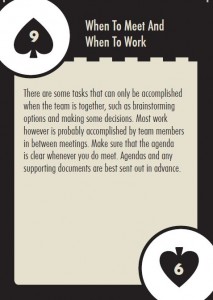Be honest … are you guilty of leading boring or bad meetings? I know I have been even though I should know better. Many years ago now, the brilliant (and much younger!) John Cleese dramatized his meeting sins in a now famous training video:
- failing to prepare himself
- failing to inform others of what a meeting was about
- failing to plan the agenda
- failing to control the discussion
- failing to record the decisions
This shortened YouTube version of the original 30 minute training video, Meetings, Bloody Meetings, is worth a watch.
A more recent and complementary take on this topic is Patrick Lencioni’s fable Death by Meeting. Lencioni suggests that most meetings are bad because they lack drama, context and purpose. Given that the majority of important work needs to get done in meetings, he suggests team leaders become more accountable and address it in the following ways:
- Take a lesson from the movies. Hollywood movie makers know that they need to introduce some confict or high interest into the movie within the first 10 minutes. Likewise, leaders should put the most controversial or engaging topic at the beginning of their meetings.
- Schedule more meetings! Seems counterintuitive but Lencioni suggests that most leaders try to put every type of task or purpose into one meeting (probably to get away from spending too much time in meetings!) and in so doing, almost doom their meeting from the get go. He suggests teams set up four types of meetings:
- Daily Check-in – as its name implies a quick 5-10 mins “how are things going?” Avoid the temptation to spill over into the next two or this meeting won’t work!
- Weekly Tactical – This meeting should be no longer than one hour, and deal with the discussion and resolution of issues that affect the team’s short term and tactical objectives. The team should quickly decide which items should be discussed in this meeting and avoid the temptation to spill over into strategic issues. For this to work, the team needs to be crystal clear on its priorities in order to spend its time on the right issues.
- Monthly Strategic – This is the meeting for discussion of topics that will have a long term impact on the business. These meetings should be longer and include time for exploration, brainstorming and open dialogue. Limit discussion to a few topics and allow 1-2 hours for each topic.
- Quarterly Off-site Review – As the name implies these meetings are for people to step away from the day to day business, take a time out and reflect upon the entire big picture – how the team is doing, morale, engagement, the company’s strategy, trends affecting the business and so on. These reviews can last anywhere from half a day to two days.
In our work with many teams, we see a few patterns. One is the team that has a difficult time discussing strategy even when they are in a strategy meeting. This can be because people on the team lack expertise or the tools to discuss strategy. Two is the type of team who, as Lencioni suggests, tries to accomplish every task at every meeting. Three is the team that doesn’t ever take time away for an off-site review or retreat because they don’t have time. Ironically, the less time they spend on these types of off-sites the more time they spend frittering their time away on the wrong kinds of things and/or getting into interpersonal conflict.
What strategies have you used to ensure folks look forward to meetings instead of dreading them?
This blog is based on the 9 of Spades, When to Meet and When to Work, taken from our Teamwork Explorer. Written by Tammy.
